Neonatology (Perinatology)
- Page Path
-
- HOME
- TOPICS
- Neonatology (Perinatology)
- Topics
-
- Adolescence Medicine (4)
- Allergy (62)
- Cardiology (81)
- Critical Care Medicine (13)
- Developmental and Behavioral Medicine (24)
- Emergency Medicine (5)
- Endocrinology (64)
- Gastroenterology (73)
- General Pediatrics (57)
- Genetics and Metabolism (26)
- Hematology (19)
- Immunology (16)
- Infection (78)
- Neonatology (Perinatology) (125)
- Nephrology (Genitourinary) (54)
- Neurology (96)
- Nutrition (32)
- Oncology (17)
- Neurobehavior (12)
- Pulmonology (34)
- Rheumatology (3)
- Other (43)
- Original Article
- Neonatology (Perinatology)
- Risk-based maternal group B Streptococcus screening strategy is compatible with the implementation of neonatal early-onset sepsis calculator
- Niek B. Achten, J. Wendelien Dorigo-Zetsma, Annemarie M.C. van Rossum, Rianne Oostenbrink, Frans B. Plötz
- Clin Exp Pediatr. 2020;63(10):406-410. Published online April 16, 2020
-
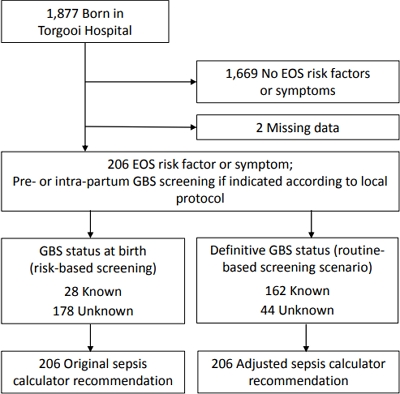
Question: To what extent does risk-based Group B Streptococcus (GBS) screening influence management recommendations by the early-onset sepsis (EOS) calculator?
Finding: In 97% of the newborn infants, the EOS calculator recommendation remained unchanged after the GBS status at birth was updated to the definitive GBS status.
Meaning: Risk-based GBS screening results are compatible with EOS calculator recommendations.
- New modified version of the Risk Adjustment for Congenital Heart Surgery category and mortality in premature infants with critical congenital heart disease
- Young Mi Yoon, Seong Phil Bae, Yoon-Joo Kim, Jae Gun Kwak, Woong-Han Kim, Mi Kyoung Song, Seung Han Shin, Ee-Kyung Kim, Han-Suk Kim
- Clin Exp Pediatr. 2020;63(10):395-401. Published online July 15, 2020
-
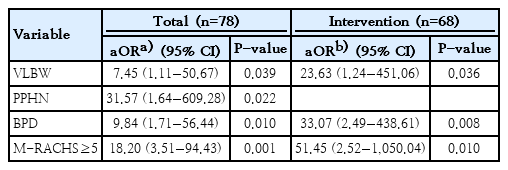
Questions: This study aimed to describe the survival of premature infants with critical congenital heart disease (CHD) and to identify the risk factors including the new modified version of the Risk Adjustment for Congenital Heart Surgery (M-RACHS) associated with mortality.
Finding: For premature infants with critical CHD, survival rate was 76.9% and very low birth weight (VLBW), persistent pulmonary hypertension of the newborn (PPHN), bronchopulmonary dysplasia (BPD), and M-RACHS 5 or more were associated with in-hospital mortality.
Meaning: VLBW, PPHN and BPD, as well as M-RACHS≥5, were risk factors for mortality among premature infants with critical CHD.
- Editorial
- Neonatology (Perinatology)
- Utility of neonatal early-onset sepsis calculator in risk-based group B Streptococcus screening approach
- Myo-Jing Kim
- Clin Exp Pediatr. 2020;63(10):393-394. Published online May 22, 2020
-
· Evaluation of the risk factors for early-onset sepsis (EOS) is important to optimal prevention and treatment.
· The EOS calculator is still valid as part of the risk-based group B Streptococcus (GBS) screening approach.
· The risk factor assessment using the EOS calculator is worth use before the introduction of universal GBS screening.
- Risk factors for in-hospital mortality in premature infants with critical congenital heart disease
- Jeonghee Shin
- Clin Exp Pediatr. 2020;63(10):391-392. Published online October 6, 2020
-
The incidence and mortality rates of critical congenital heart disease (CHD) are higher in preterm than in term infants. The risk factors for in-hospital mortality in premature infants with critical CHD are unclear. However, the mortality of preterm infants with critical CHD may be related to CHD complexity as well as gestational age, birth weight, the presence of prematurity-associated comorbidities, and the treatment itself.
- Clinical Note
- Neonatology (Perinatology)
- Management of the first newborn delivered by a mother with COVID-19 in South Korea
- Eun-Kyung Lee, Won Duck Kim, Dong won Lee, Sang-Ah Lee
- Clin Exp Pediatr. 2020;63(9):373-375. Published online July 13, 2020
-
Question: How to manage the newborn born to the coronavirus disease 2019 (COVID-19) pregnant?
Finding: Medical staff managed the delivery and neonatal care of a COVID-19 pregnant patient was based on the “Guidelines for COVID-19 response.”
Meaning: We desire that our management will help treat for subsequent patients and there should be updated continuously the prevention and control consensus strategies for newborn COVID-19.
- Editorial
- Neonatology (Perinatology)
- Survival model application for analysis of neonatal length of stay
- Eun Joo Lee
- Clin Exp Pediatr. 2020;63(9):357-358. Published online May 14, 2020
-

- Original Article
- Neonatology (Perinatology)
- Evaluation of the role of ischemia modified albumin in neonatal hypoxic-ischemic encephalopathy
- Mohamed A. Talat, Rabab M. Saleh, Mohammed M. Shehab, Naglaa A. Khalifa, Maha Mahmoud Hamed Sakr, Walaa M. Elmesalamy
- Clin Exp Pediatr. 2020;63(8):329-334. Published online August 15, 2020
-
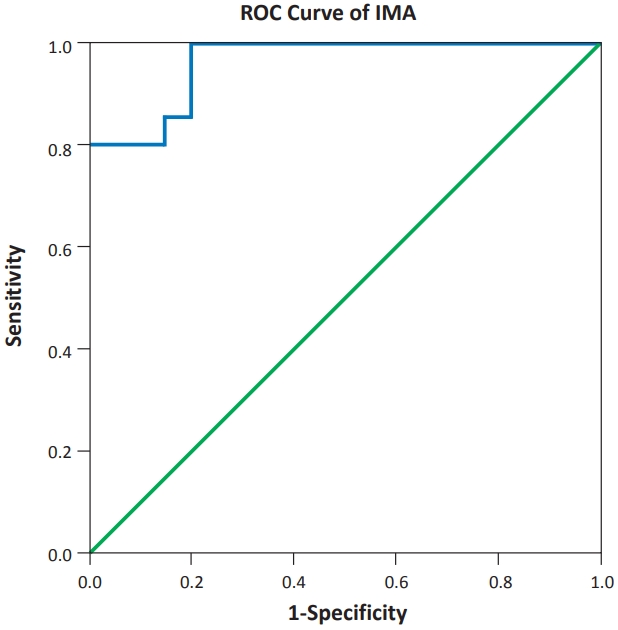
Question: What is the value of ischemia modified albumin (IMA) as a diagnostic marker for neonatal hypoxic-ischemic encephalopathy (HIE)?
Finding: IMA levels were significantly higher (nearly double elevation) in hypoxic than healthy newborns in the first few hours after birth in the full-term neonates.
Meaning: IMA can be a reliable marker for the early diagnosis of neonatal HIE and can be a predictor of injury severity.
- Review Article
- Neonatology (Perinatology)
- Short- and long-term outcomes of very low birth weight infants in Korea: Korean Neonatal Network update in 2019
- Jang Hoon Lee, YoungAh Youn, Yun Sil Chang; Korean Neonatal Network
- Clin Exp Pediatr. 2020;63(8):284-290. Published online February 5, 2020
-
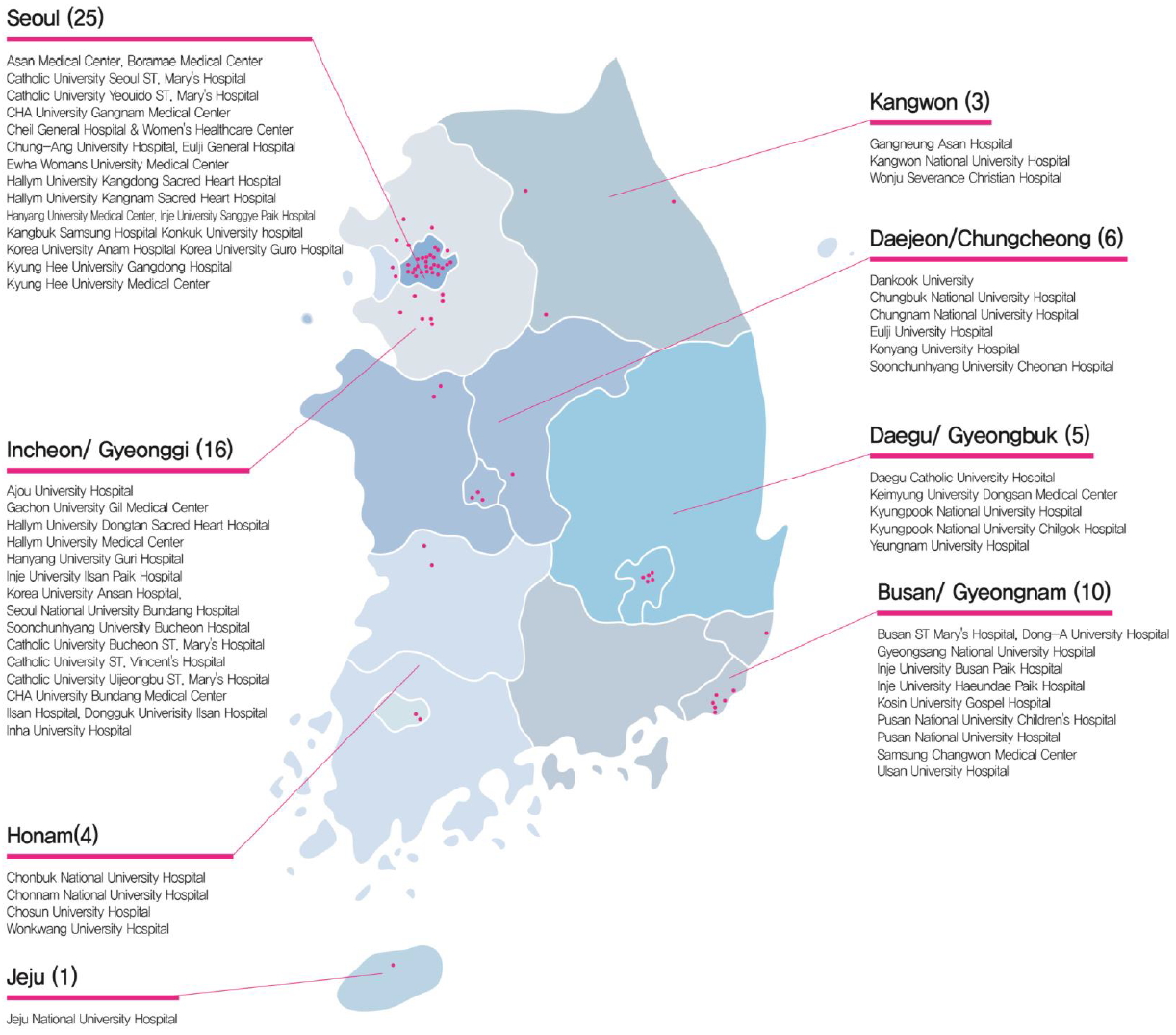
The Korean Neonatal Network (KNN) has collected population-based data for very low birth weight infants (VLBWIs) born in Korea since 2013. The survival rate of all VLBWIs was 86% in Korea. The overall prevalence of cerebral palsy was 6.2%–6.6%. Bilateral blindness and hearing loss were reported in 0.2%–0.3%, 0.8%–1.9%, respectively. The KNN has published annual reports and papers for facilitating the improvement of VLBWIs outcome in Korea.
- Original Article
- Neonatology (Perinatology)
- Synbiotics use for preventing sepsis and necrotizing enterocolitis in very low birth weight neonates: a randomized controlled trial
- Ozge Serce Pehlevan, Derya Benzer, Tugba Gursoy, Guner Karatekin, Fahri Ovali
- Clin Exp Pediatr. 2020;63(6):226-231. Published online February 5, 2020
-
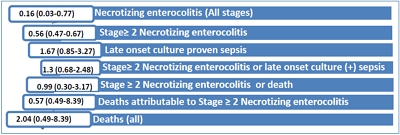
Background: Probiotics and prebiotics have strain-specific effects on the host. Synbiotics, a mixture of probiotics and prebiotics, are proposed to have more beneficial effects on the host than either agent has alone.
Purpose: We performed a randomized controlled trial to investigate the effect of Lactobacillus and Bifidobacterium together with oligosaccharides and lactoferrin on the development of necrotizing enterocolitis (NEC) or sepsis...
- Long-term cognitive, executive, and behavioral outcomes of moderate and late preterm at school age
- Ju Hyun Jin, Shin Won Yoon, Jungeun Song, Seong Woo Kim, Hee Jung Chung
- Clin Exp Pediatr. 2020;63(6):219-225. Published online September 25, 2019
-
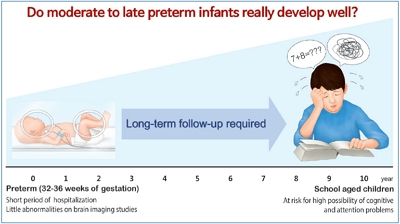
Question: Infants born at moderate to late preterm gestations are known to have little problem later on, but is that really true?
Finding: At school age, cognitive problem was observed in about a quarter of the children. In addition, more than half of the children was suspected of having attention problems.
Meaning: Moderate to late preterm infants are at risk of developing abnormal intelligence and attention problems at early school age, therefore they should not be neglected on longterm follow-up evaluation.
- Editorial
- Neonatology (Perinatology)
- Should we regularly evaluate the neurodevelopmental status of moderate and late preterm infants?
- Son Moon Shin
- Clin Exp Pediatr. 2020;63(6):217-218. Published online June 11, 2020
-

- What do we know about the long-term cognitive and behavioral outcomes of school-aged children who were born moderate to late preterm?
- Eun Sun Kim
- Clin Exp Pediatr. 2020;63(6):215-216. Published online February 5, 2020
-
- Epidermal growth factor as a reliable marker of necrotizing enterocolitis in preterm neonates
- Na Mi Lee
- Clin Exp Pediatr. 2020;63(4):133-134. Published online September 18, 2019
-
- Letter to the Editor
- Neonatology (Perinatology)
- Risk factors for BiPAP failure as an initial management approach in moderate to late preterm infants with respiratory distress
- Heekwon Son, Eui Kyung Choi, Kyu Hee Park, Jeong Hee Shin, Byung Min Choi
- Clin Exp Pediatr. 2020;63(2):63-65. Published online February 15, 2020
-

Question: Which factors can predict BiPAP failure as the initial management approach for moderate to late preterm infants with respiratory distress?
Finding: RDS aggravation and increased oxygen and frequency requirements during BiPAP support were associated with BiPAP failure.
Meaning: Early changes to invasive ventilator care should be considered for moderate to late preterm infants showing RDS aggravation and increased oxygen and frequency requirements during BiPAP support.
- Original Article
- Neonatology (Perinatology)
- Effect of red blood cell transfusion on short-term outcomes in very low birth weight infants
- Eui Young Lee, Sung Shin Kim, Ga Young Park, Sun Hyang Lee
- Clin Exp Pediatr. 2020;63(2):56-62. Published online February 6, 2020
-

Question: Does RBC transfusion affect the short-term outcomes of VLBW infants?
Finding: The results showed that RBC transfusion was significantly related to the incidence of BPD (OR, 5.42; P<0.001) and NEC (OR, 3.40; P=0.009).
Meaning: Careful consideration of the patient’s clinical condition and appropriate guidelines is required before administering RBC transfusions.
- Placental histopathology in late preterm infants: clinical implications
- Kristina Ericksen, Joshua Fogel, Rita P. Verma
- Clin Exp Pediatr. 2020;63(2):48-51. Published online August 19, 2019
-
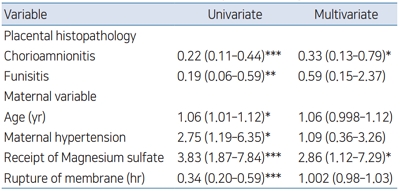
Question: Placental histopathology and its clinical implications in late preterm infants.
Finding: Placental vascular anomalies are more, and placental inflammation less common in late preterm infants compared to term. Higher maternal age, magnesium sulfate therapy and hypertension are clinical risk factors associated with late preterm delivery.
Meaning: Prevention and aggressive management of hypertension, and conception before 30 years of age might be effective in preventing late preterm births.
- Effectiveness of various nonpharmacological analgesic methods in newborns
- Pancham Kumar, Rakesh Sharma, Sukhdev Rathour, Sunidhi Karol, Mohit Karol
- Clin Exp Pediatr. 2020;63(1):25-29. Published online August 16, 2019
-
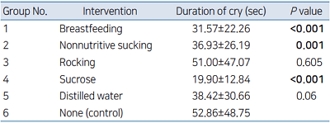
Question: Can nonpharmacological methods be used for neonatal pain management.
Finding: Nonpharmacological methods like Sucrose, breastfeeding etc have shown to significantly reduce the pain caused by intramuscular hepatitis B vaccination.
Meaning: Nonpharmacological methods are the safe and cheap potential modalities of analgesia which can be used during mild to moderate pain in newborns.
- Editorial
- Neonatology (Perinatology)
- Prevention and management of pain in the neonatal intensive care unit
- Sung Shin Kim
- Clin Exp Pediatr. 2020;63(1):16-17. Published online January 15, 2020
-
- Original Article
- Neonatology (Perinatology)
- Hypoxia-inducible factor: role in cell survival in superoxide dismutase overexpressing mice after neonatal hypoxia-ischemia
- Ga Won Jeon, R. Ann Sheldon, Donna M Ferriero
- Clin Exp Pediatr. 2019;62(12):444-449. Published online October 18, 2019
-
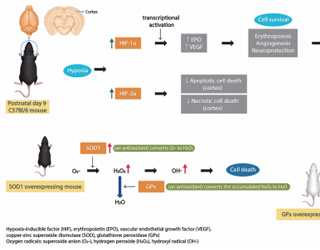
Background: Sixty percent of infants with severe neonatal hypoxic-ischemic encephalopathy die, while most survivors have permanent disabilities. Treatment for neonatal hypoxic-ischemic encephalopathy is limited to therapeutic hypothermia, but it does not offer complete protection. Here, we investigated whether hypoxia-inducible factor (HIF) promotes cell survival and suggested neuroprotective strategies.
Purpose: HIF-1α-deficient mice have increased brain injury after neonatal hypoxia-ischemia (HI), and the...
- Editorial
- Neonatology (Perinatology)
- Practical considerations when administering surfactants to preterm infants with respiratory distress syndrome
- Heui Seung Jo
- Clin Exp Pediatr. 2019;62(12):440-441. Published online August 16, 2019
-
- Eosinophil count and neutrophil-to-lymphocyte count ratio as biomarkers for predicting early-onset neonatal sepsis
- Jang Hoon Lee
- Clin Exp Pediatr. 2019;62(12):438-439. Published online July 9, 2019
-
- Clinical note
- Neonatology (Perinatology)
- Gray-brown skin discoloration following phototherapy for hyperbilirubinemia due to anti-E alloimmunization
- Da Jeong Lee, Woo Sun Song, Seung Yeon Kim
- Clin Exp Pediatr. 2019;62(11):428-430. Published online September 18, 2019
-
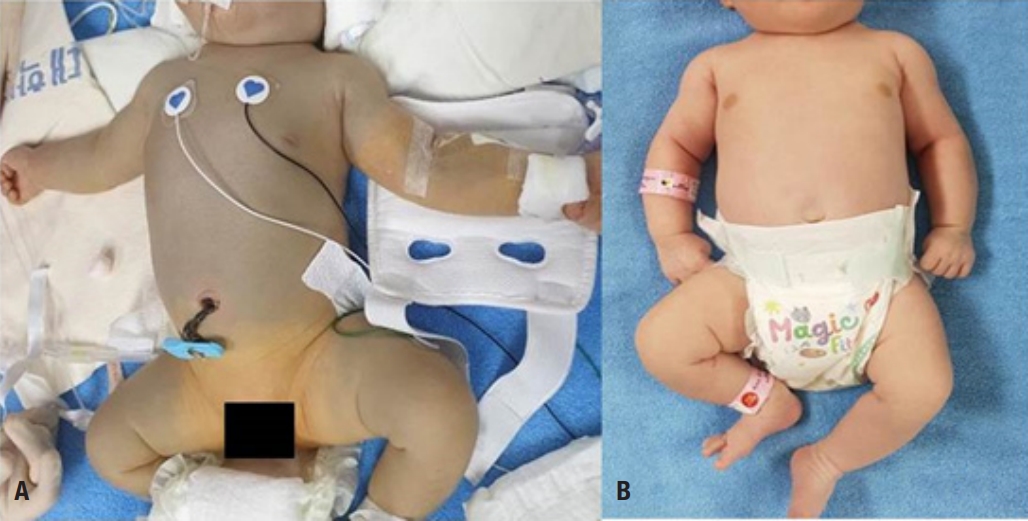
- Editorial
- Neonatology (Perinatology)
- Controversy in the diagnosis and treatment of hemodynamically significant patent ductus arteriosus in preterm infants
- Se In Sung
- Clin Exp Pediatr. 2019;62(11):410-411. Published online June 21, 2019
-
- Original Article
- Neonatology (Perinatology)
- Clinical impact of admission hypothermia in very low birth weight infants: results from Korean Neonatal Network
- Na Hyun Lee, Soo Kyung Nam, Juyoung Lee, Yong Hoon Jun
- Clin Exp Pediatr. 2019;62(10):386-394. Published online May 22, 2019
-

Background: Preterm infants have difficulty maintaining body temperature after birth. However, clinical guidelines advocate that neonatal body temperature should be maintained at 36.5°C–37.5°C.
Purpose: We aimed to investigate the incidence of admission hypothermia in very low birth weight (VLBW) infants and to determine the association of admission temperature with in-hospital mortality and morbidities. Methods: A cohort study using prospectively collected data involving...
- Editorial
- Neonatology (Perinatology)
- Central line-associated bloodstream infections in the neonatal intensive care unit
- Woo Ryoung Lee
- Clin Exp Pediatr. 2019;62(10):382-383. Published online July 17, 2019
-
- Strategies to improve outcomes of bronchopulmonary dysplasia
- Young Hwa Jung, Chang Won Choi, Beyong Il Kim
- Clin Exp Pediatr. 2019;62(10):380-381. Published online September 11, 2019
-
- Review Article
- Neonatology (Perinatology)
- Bronchopulmonary dysplasia: how can we improve its outcomes?
- Tae-Jung Sung
- Clin Exp Pediatr. 2019;62(10):367-373. Published online May 17, 2019
-

Bronchopulmonary dysplasia (BPD) is a chronic lung disease of preterm infants with multiple factors affected from prenatal to postnatal periods. Despite significant advances in neonatal care over almost 50 years, BPD rates have not decreased; in fact, they may have even increased. Since more preterm infants, even at periviable gestational age, survive today, different stages of lung development affect the...
- Original Article
- Neonatology (Perinatology)
- The relation between serum levels of epidermal growth factor and necrotizing enterocolitis in preterm neonates
- Heba Mostafa Ahmed, Nsreen Mostafa Kamel
- Clin Exp Pediatr. 2019;62(8):307-311. Published online March 15, 2019
-
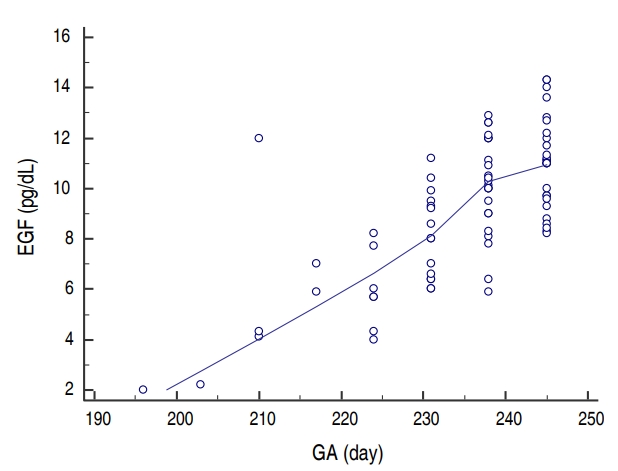
Purpose: Necrotizing enterocolitis (NEC) is one of the most serious complications of prematurity. Many risk factors can contribute to the development of NEC. The epidermal growth factor (EGF) plays a major role in intestinal barrier function, increases intestinal enzyme activity, and improves nutrient transport. The aim of this study was to assess the role of epidermal growth factor in the...
- Review Article
- Neonatology (Perinatology)
- Practice for preterm patent ductus arteriosus; focusing on the hemodynamic significance and the impact on the neonatal outcomes
- Jin A Lee
- Clin Exp Pediatr. 2019;62(7):245-251. Published online April 8, 2019
-

Hemodynamically significant preterm patent ductus arteriosus (PDA) affects mortality; comorbidities such as necrotizing enterocolitis, intraventricular hemorrhage, and bronchopulmonary dysplasia; and adverse long-term neurodevelopmental outcomes in preterm infants, particularly in very low birth weight infants. However, recent studies have indicated that there is no consensus on the causal relationship between PDA and neonatal outcomes, the benefit of PDA treatment, the factors...
- Original Article
- Neonatology (Perinatology)
- Diagnostic value of eosinopenia and neutrophil to lymphocyte ratio on early onset neonatal sepsis
- Rocky Wilar
- Clin Exp Pediatr. 2019;62(6):217-223. Published online October 8, 2018
-

Purpose: To determine the diagnostic value of eosinopenia and the neutrophil-to-lymphocyte ratio (NLR) in the diagnosis of early onset neonatal sepsis (EONS). Methods: This cross-sectional study was conducted in the Neonatology Ward of R.D. Kandou General Hospital Manado between July and October 2017. Samples were obtained from all neonates meeting the inclusion criteria for EONS. Data were encoded using logistic regression...
-

-
-
6.02024CiteScore98th percentilePowered by
-
Impact Factor3.6
-
- TOPICS
- ARTICLE CATEGORY
- Editorial Office
-
Korean Pediatric Society
#1606 Seocho World Officetel, 19 Seoun-ro, Seocho-ku, Seoul 06732, Korea
Tel: +82-2-3473-7306 Fax: +82-2-3473-7307 E-mail: office@e-cep.org
Clinical and Experimental Pediatrics is an open access journal. All articles are distributed under the terms of the Creative Commons Attribution NonCommercial License (http://creativecommons.org/licenses/by-nc/4.0/)
Copyright © 2025 by Korean Pediatric Society.











